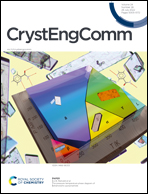Structural transformation of metal oxo species within UiO-66 type metal–organic frameworks†
Abstract
Studying the coordination of actinide-based metal oxo clusters can provide valuable insights for nuclear energy technologies and radioactive waste containment. Metal–organic frameworks serve as a platform to directly interrogate the structure and properties of understudied actinide elements, including thorium. Examples of structural evolutions within Th oxo species within MOFs are rare yet relevant for nuclear waste speciation in solution. Herein, we report the serendipitous discovery of the structural evolution of Th-UiO-66 containing a hexanuclear Th node to a mononuclear Th(bdc)2(dmf)2 upon the evaporation of solvent from the reaction. We observe a partial reversal of Th(bdc)2(dmf)2 back to Th-UiO-66 upon hydrothermal treatment, indicating the complex dynamics of Th oxo species in solution. We report that isolated Ce-UiO-66 similarly transforms to a newly isolated 1D CeIII carboxylate chain MOF named NU-351 under the same conditions as Th-UiO-66, while Zr-UiO-66 and Hf-UiO-66 retain their structures.



 Please wait while we load your content...
Please wait while we load your content...